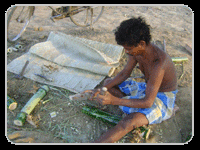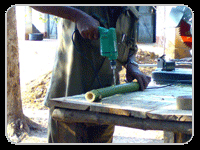
Different methods of propagation are followed to obtain planting materials for multiplication of bamboo. The easiest method is to raise seedlings from the seeds. Sees can be procured from the area where sporadic or gregarious flowering has occurred. The bamboo sees have not dormancy but the viability period is limited. To obtain higher percentage of germination, fresh sees should be sown immediately after collection. After sowing the seeds in the mother beds, light straw cover is to be provided for 2-3 days to enhance the germination. Prophylactic treatment may be required to guard against termite/fungal attack. Germination starts between 4-10 days after sowing. After a month these seedlings can be transplanted to poly pots of 24 cm x 18 cm filled with soil mixture and be maintained for a year before plating.
Since the seeds of many bamboo species are not available regularly, various methods of vegetative propagation have been developed / practiced. The methods generally used are :
 Macro-proliferation : In the early stage of growth of the seedlings the young sprouts along with a portion of rhizome are separated from mother plant and grown in other poly pots. 3-4 sprouts can be obtained from each seedling over a period of 6 month. The detail method has been described separately.
Macro-proliferation : In the early stage of growth of the seedlings the young sprouts along with a portion of rhizome are separated from mother plant and grown in other poly pots. 3-4 sprouts can be obtained from each seedling over a period of 6 month. The detail method has been described separately.
Layering : Whole bamboo layering method has been adopted to develop rooting and sprouting at each node. The young culms are bent down to ground level and buried under the soil over the entire length. Regular watering is required to keep the soil moist. After the sprouts growing from the nodes develop basal rhizome, the internodes can be separated and planted.
Culm cutting layering : Bi-nodal and multi-nodal culm cuttings have been used to produce plating materials in large scale. The age of the culm and the period when these cuttings are layered for rooting are important factors. Second year old culm and layering in the month of March-April have been found to give best results. The standard method is described separately.

Branch cuttings : The bamboo branches can be used to produce propagules under regulated environmental conditions.
Branch cuttings : The bamboo branches can be used to produce propagules under regulated environmental conditions.
In Odisha except for Salia bamboo (D.strictus), which is propagated by raising seedlings from the seeds, multiplication is through offset planting only. This method, through practiced by the villagers from ages, has limited application for undertaking extensive plantation because of the limited availability of the planting material. However, the vegetative propagation methods such as macro-proliferation and rooted-culm-cuttings can be successful with most of the commercially important bamboo species for raising large-scale plantations.
The Technique of Seedling Multiplication (Macro-proliferation)
Young bamboo seedlings produce a large number of tillers till the rhizome is fully grown to produce usable culms. This characteristic has been utilized to produce a number of propagules from one viable seed at least or few years. Since the seeds of bamboo are not available every year, this method of propagation can be depended upon to raise regular plantations. Seedling multiplication through the technique of macro proliferation can ensure continuous supply of large number of plating material for a couple of years.

Young seedlings can be raised in mother bed of 40 x 4 by sowing seeds (50gm 100 gm/ bed). After germination, one to two months old seedling should be transplanted at spacing of 6 x 6 (or 6 x 4) preferably in July in other bed. Casualty should be replaced in bed time to time to ensure full stocking. The stock (one year old) can be used during next year by planting rhizome directly (up rooting with soil). This will reduce transportation cost. The growth of rhizome in the bed (soil) is usually better than ploypot which is important for survival of bamboo plantation.
At this stage proliferated seedlings from the bed may be separated with tillers and rhizome in the bed for further macro propagation which can be used again after one year.
It is advisable not to raise seedling in polypot as rhizomes are not grown properly in the polypot.
Seedling Production by Layering of Culm-Cuttings

Young (2 year old) and healthy culms from selected clumps are extracted by cutting just above the second node. The leaves & side branches are trimmed off and the bamboo is cut in to a number of bi-nodal (one inter node with two nodes) pieces.
Care is taken to avoid splitting of the cut ends while preparing the bi-nodal pieces.
A hole is made on the inter node to fill water in the lumen. While making the hole, care is taken to ensure that the lateral branches are parallel to the ground & the hole is perpendicular to the branching joint.
 After filling water in the lumen, the hole is closed by wrapping with cello-tape to prevent leakage.
After filling water in the lumen, the hole is closed by wrapping with cello-tape to prevent leakage.
These water-filled cuttings are layered in the sunken nursery beds of 6 mt. long and 0.75 mt wide and covered with 4-5 cm deep soil.
One week prior to layering, the nursery beds are prepared by tilling the land, applying farmyard manure and drenching the soil with the insecticide (Aldrin) & the fungicide (Bavistin) to prevent termite & fungal attack. The bi-nodal cuttings are laid in the soil beds parallel to each other at 30 cm. apart keeping the hole up towards surface. Watering has to be done regularly to keep the soil moist.

Within a week the bunds and roots sprout from the nodal meristem. Usually three to five tillers come up from each node.
Development of roots at the node is just not enough to ensure survival after planting. The tillers must have strong rhizome formation before planting in the field. At least six months are required to ensure development of rhizomes for each tiller that comes up from the node.
After 6 months, these bi-nodal pieces can be removed from the bed and planted directly in the field even after splitting to uni-nodal pieces.
It has been observed that two-year-old culms are best for the purpose and spring season is the appropriate time for  layering of culm cuttings. Since this method does not involve any critical technique, it can be easily practiced by the farmers to get at least 50-75 plantable seedlings from each bamboo culm.
layering of culm cuttings. Since this method does not involve any critical technique, it can be easily practiced by the farmers to get at least 50-75 plantable seedlings from each bamboo culm.